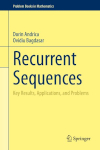- About MAA
- Membership
- MAA Publications
- Periodicals
- Blogs
- MAA Book Series
- MAA Press (an imprint of the AMS)
- MAA Notes
- MAA Reviews
- Mathematical Communication
- Information for Libraries
- Author Resources
- Advertise with MAA
- Meetings
- Competitions
- Programs
- Communities
- MAA Sections
- SIGMAA
- MAA Connect
- Students
- MAA Awards
- Awards Booklets
- Writing Awards
- Teaching Awards
- Service Awards
- Research Awards
- Lecture Awards
- Putnam Competition Individual and Team Winners
- D. E. Shaw Group AMC 8 Awards & Certificates
- Maryam Mirzakhani AMC 10 A Awards & Certificates
- Two Sigma AMC 10 B Awards & Certificates
- Jane Street AMC 12 A Awards & Certificates
- Akamai AMC 12 B Awards & Certificates
- High School Teachers
- News
You are here
Recurrent Sequences

Publisher:
Springer
Publication Date:
2020
Number of Pages:
416
Format:
Hardcover
Series:
Problem Books in Mathematics
Price:
69.99
ISBN:
978-3-030-51501-0
Category:
Problem Book
[Reviewed by , on ]
Russel Jay Hendel
04/10/2022
What a delightful, current, compactly written book. This book could serve as a stand-alone text i) for an advanced, undergraduate, second-term, Discrete-Mathematics course, ii) for a first, or preferably, second-year stand-alone text for graduate students specializing in dynamical systems, combinatorics, or discrete systems, or iii) for researchers in these areas. The prerequisites for reading the book include complex analysis, linear algebra, number theory, and basic combinatorics. However, specific collections of chapters, might have lighter prerequisites.
The book’s content is spread over 30 sections making it ideal for a 15-week, 2-day-a-week course. There are plenty of problems: The last 2 chapters contain 123 Olympiad-type problems (many original) and worked out solutions. Additionally the individual chapters contain many worked out examples. For example, Chapter 2, “Basic Recurrent Sequences” contains 28 worked out examples with a wide spread of topics including first-order recurrences, second-order recurrences, homographic recurrences, and recurrences presented by matrices. Certainly, enough problems for any course.
The authors have a marvelous capacity for summarizing entire topics in a few pages. For example, Section 1.5, lists in 12 pages 15 very diverse applications of recurrences, including solutions to Pell’s equation, numerical analysis, the logistic population model and many more. This compact summarizing of examples continues throughout the book. Similarly, Section 2.2.4 lists in 11 pages 10 “famous” second order recurrences with their recursions, polynomial families, and generating functions. The list is varied including the well-known Fibonacci-Lucas recurrences, intermediately known recurrences such as the Chebyshev (1st and 2nd kind), as well as the lesser known recurrences such as Brahmagupta. Similarly, properties of many sequences are neatly summarized in one-stop theorems.
The authors advocate multiple and fresh proof approaches. There is an emphasis on the geometric representation of recurrences in the complex plane. New matrix proofs of familiar results are presented. For example, a matrix proof is presented for \( \mathrm{gcd}(U_{m},U_{n}) = U_{\mathrm{gcd}(m,n)} \) where gcd stands, as usual, for greatest common divisor, and \( \left\{ U_{m} \right\} \) spans a wide range of second order recurrences.
The book elegantly treats periodicity, orbits, orbit geometry, and several related topics, accompanied by numerous figures in color.
Kudos to the authors for including analytic results in a book about discrete recurrences consistent with the “multiple proof approach” used throughout the book. Thus, Section 4.3 presents the Cauchy Integral formula and its applications to sequences, while appendix A.2.7 presents the celebrated result, attributed to Weyl, that \( \left\{nx \right\} \), the fractional part of \( nx \), with \( n \) varying over the integers and \( x \) a fixed real is dense in \( [0,1] \).
The book presents close to 200 references most of which are post-2000. Anyone wanting to read further will find what they need here.
Although occasional errors do crop up, these are usually minor and easily fixable. For example, on page 284 in the solution to Problem 3, the expression \( (2^{k-1}+1-i)^{2}+2k \), \( i=0, 1, \ldots, 2^{k-1}\) should really be \( (2^{k-1}+i-1)^{2} +2^{k} \), \( i=1, \ldots, 2^{k-1} \), the errors consisting of typical typographical errors, a missed superscript, a reversal of signs, and an incorrect bound. I do not believe such minor errors would seriously confuse any reader and they do not detract from the praise given above.
Russell Jay Hendel, RHendel@Towson.Edu, holds a Ph.D. in theoretical mathematics and an Associateship from the Society of Actuaries. He teaches at Towson University. His interests include discrete number theory, graph theory, applications of technology to education, problem writing, theory of pedagogy, actuarial science, and the interaction between mathematics, art, and poetry.
See the publisher's website.
- Log in to post comments




